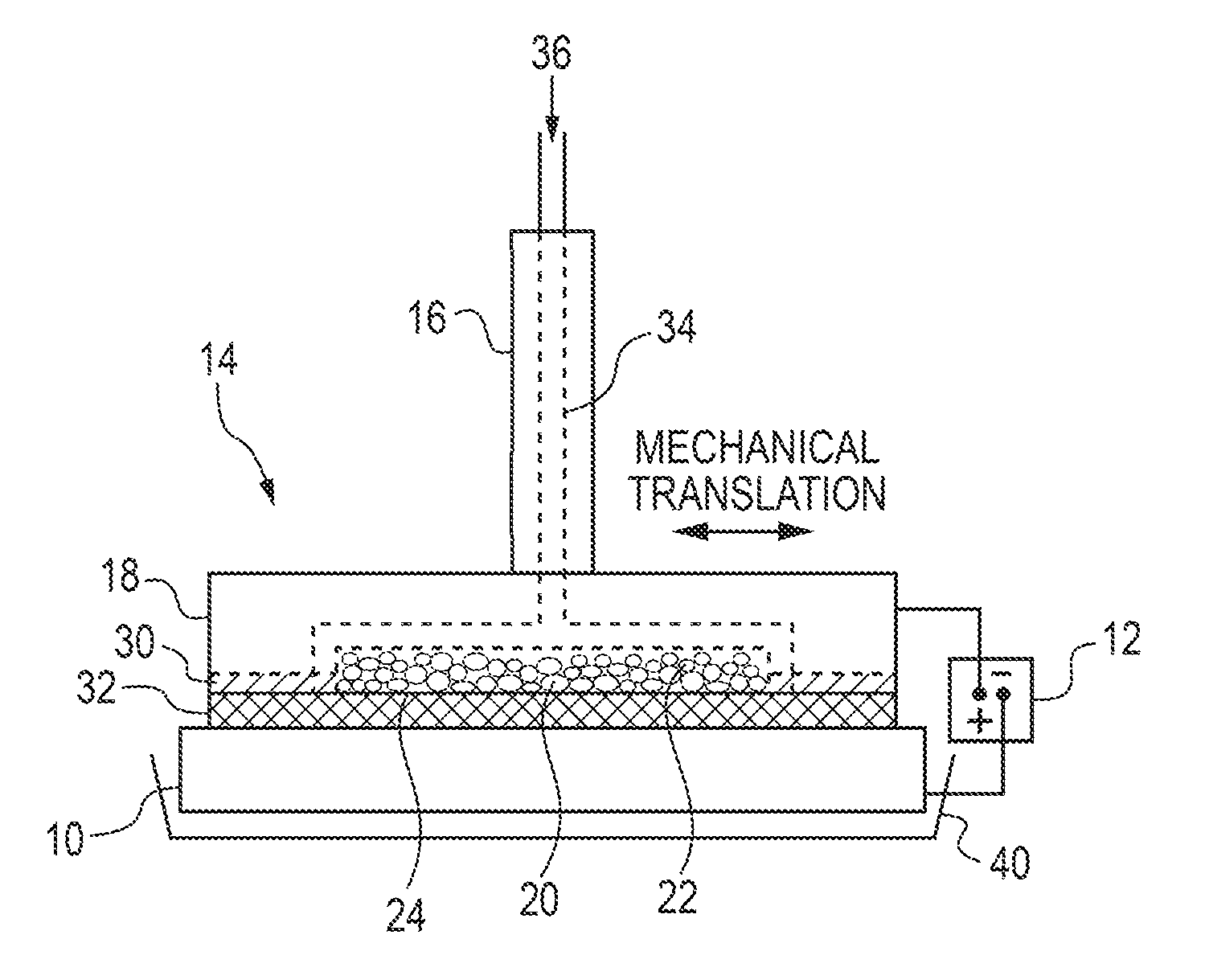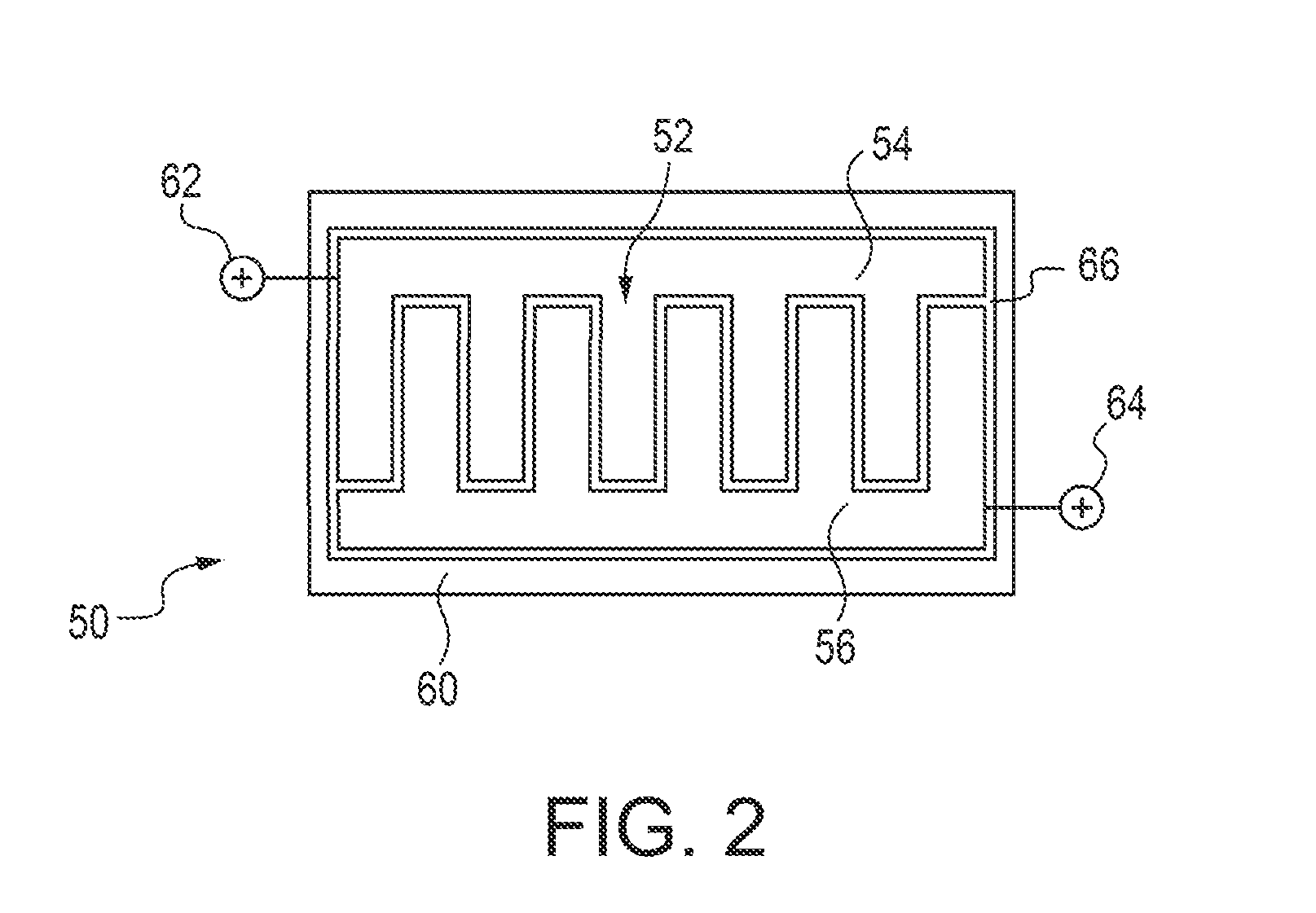Flow-through consumable anodes
a consumable anode and flow-through technology, applied in the direction of electrolysis processes, electrolysis devices, cells, etc., can solve the problems of unfavorable chlorine gas evolution, health and safety risks, rapid deterioration of electrolyte, etc., and achieve the effect of avoiding disintegration of soluble/consumable anodes
- Summary
- Abstract
- Description
- Claims
- Application Information
AI Technical Summary
Benefits of technology
Problems solved by technology
Method used
Image
Examples
example
Co plating, Polarization Curves DSA, DSSA
[0137]A brush plating applicator was built and operated as illustrated in FIG. 1. Specifically, a brush plating applicator (model 3030-30 Amax) from Sifco Industries Inc. (Cleveland, Ohio, USA) was suitably modified as described above. More specifically, the graphite anode applicator was modified to enable the use of DSSA or SA inserts. The brush plating applicator contained an active anode cavity having an interfacial area of up to 21 cm2 and a depth of 5 mm machined into a graphite anode tool housing which provided for electrolyte feed channels and electrical contact and served as current collector for the active anode insert. A cotton absorber was placed over the brush applicator containing the anode insert. The absorber also served as electrolyte spacer and provided a gap between the anode and cathode of ˜1 mm.
[0138]A plating solution was pumped into the modified anode brush applicator and exited through the anode inserts and the absorber...
example 2
Co Plating, Voltage with Increased Plating Time DSA, DSSA
[0144]For Example 2, the plating set up and conditions described Example 1 were used. The workpiece was a mild steel plate. The electrolyte was preheated to 80° C. The total electrolyte solution for all trials was 1.7 liters and the electrolyte was circulated at a flow rate of 300 ml / min. The anode inserts had an effective interfacial area of 21 cm2 and the current density applied was 150 mA / cm2. DSA and Co-based consumable anodes (DSSA) were employed while electrodepositing CoP as in Example 1 for 90 minutes. FIG. 4 shows the graph for the DSA and two DSSAs (one using Co on a graphite foam substrate and the other one using Co on a polymer foam substrate). FIG. 4 indicates that the applied cell voltage for DSAs was between 5 and 6V, whereas the applied cell voltage for Co-DSSA inserts on a polymer substrate was ˜1.5V. Co-DSSA inserts using Co deposited on graphite foam initially had a low applied cell voltage which, after abou...
example 3
CoP Plating, Loss of H3PO3
[0145]For Example 3, the plating set up and plating conditions described in Example 2 were used including a commercial electrolyte for depositing fine-grained Co—P alloys available from Integran Technologies Inc. (Toronto, Ontario, Canada) containing H3PO3 as the P source. The workpiece was a mild steel plate. The anode inserts had an effective interfacial area of 21 cm2 and the average current density applied was 150 mA / cm2 (300 mA / cm2 peak, 50% duty cycle) and the electrolyte was preheated to 80° C. and circulated through the anode at 300 ml / min; the resulting deposit thickness was ˜280 microns.
[0146]The H3PO3 concentration in the electrolyte was determined analytically and the drop in H3PO3 after 4.73 Ah of plating is displayed in Table 3.1. The data indicate that, with the exception of the consumable Co anode on a polymer foam carrier (average grain size 70 nm, 388 VHN), the H3PO3 loss experienced was higher than expected when the consumable Co anode u...
PUM
| Property | Measurement | Unit |
|---|---|---|
| thickness | aaaaa | aaaaa |
| thickness | aaaaa | aaaaa |
| grain size | aaaaa | aaaaa |
Abstract
Description
Claims
Application Information
 Login to View More
Login to View More - R&D
- Intellectual Property
- Life Sciences
- Materials
- Tech Scout
- Unparalleled Data Quality
- Higher Quality Content
- 60% Fewer Hallucinations
Browse by: Latest US Patents, China's latest patents, Technical Efficacy Thesaurus, Application Domain, Technology Topic, Popular Technical Reports.
© 2025 PatSnap. All rights reserved.Legal|Privacy policy|Modern Slavery Act Transparency Statement|Sitemap|About US| Contact US: help@patsnap.com



